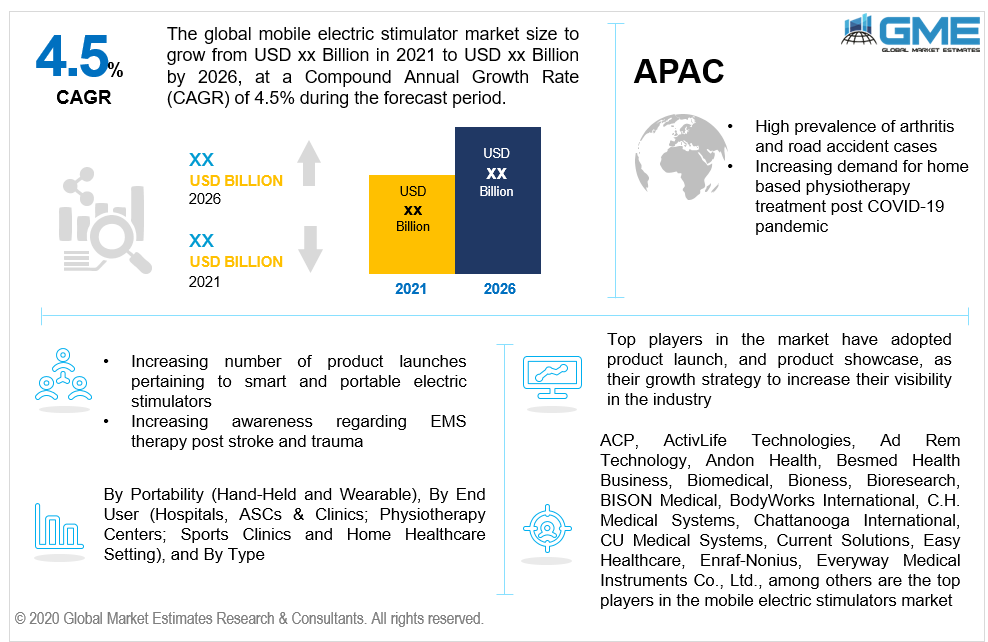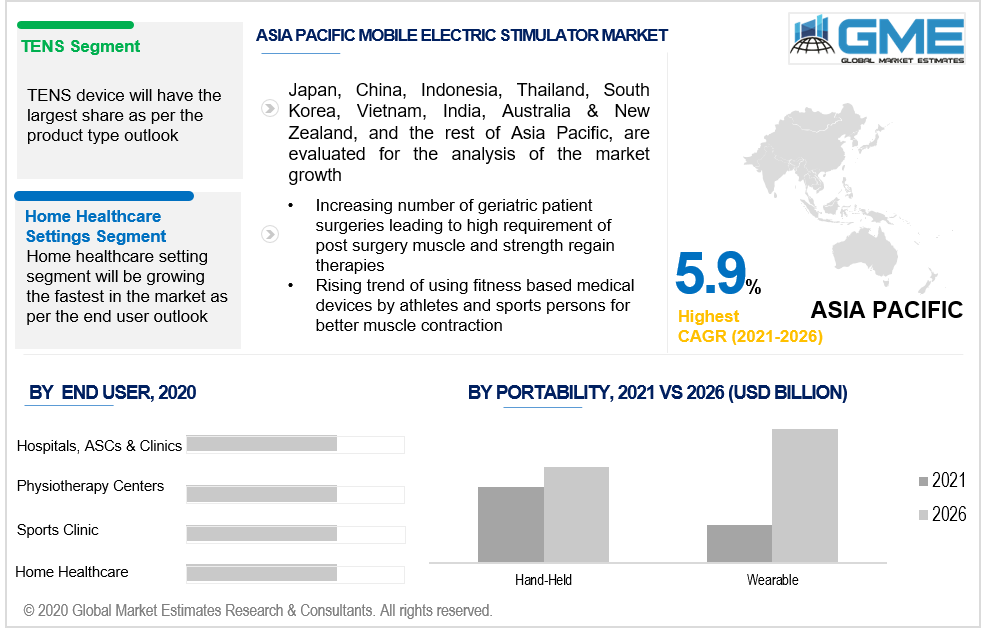
Global Mobile Electric Stimulator Market Size, Trends & Analysis - Forecasts to 2026 By Portability (Hand-Held and Wearable), By End User (Hospitals, ASCs & Clinics; Physiotherapy Centers; Sports Clinics and Home Healthcare Setting), By Type (Transcutaneous Electrical Nerve Stimulator, Neuromuscular Electrical Stimulator, Interferential Therapy, Functional Electrical Stimulator, Reciprocal EMG Triggered Stimulator, Microcurrent Electrical Neuromuscular Stimulator, Direct Current Electrical Stimulator, High-Voltage Pulsed Current Electrical Stimulator and Burst Mode Alternating Current Stimulator), End-User Landscape, Company Market Share Analysis, and Competitor Analysis
Most popular in rehabilitation treatment therapies, the electric muscle stimulator is a type of electrotherapy that helps to stimulate the patient’s muscle contraction. This treatment uses electrical impulses which help to strengthen the damaged or weak muscles, also by reducing the redness, swelling, and pain around the affected area. Besides its use in therapy, EMS is also used to increase the user's muscle tone and help render more muscle units, and boost athlete performance. This process is usually done before starting any heavy training or exercise routine. E-stim sends a mellow electrical pulse through the skin to help invigorate harmed muscles or control nerves to lessen torment. E-stim may not be suitable for everyone, except for some patients who require quick and non-invasive treatment therapy for accelerating muscle recovery and offer relief from pain.
The product is widely used by patients who require physiotherapy assistance, sportspersons, athletes, weight lifters, and geriatric patients in a controlled environment. The product in the market is hand-held and trolley-based. However, owing to increasing demand for home-based therapy and patient-centric healthcare improvements in developed countries, the market is witnessing the launch of hand-held or wearable EMS devices. The major end-users of such devices are hospitals, physiotherapy centers, sports clinics, and home healthcare settings. The market by product is segmented into transcutaneous electrical nerve stimulator, neuromuscular electrical stimulator, interferential therapy, functional electrical stimulator, reciprocal EMG triggered stimulator, microcurrent electrical neuromuscular stimulator, direct current electrical stimulator, high-voltage pulsed current electrical stimulator, and burst mode alternating current stimulator. However, the NEMS or the neuromuscular electrical stimulator is the most common type of device used for stimulation. This therapy uses very high intensity to cause stimulation of peripheral nerves and produce muscle contraction smoothly. The impulses are produced by a gadget and conveyed through anodes (cushions that stick to the skin) over the center of the muscles that require invigorating. The impulses from EMS emulate the activity potential (improvement needed to make the muscle contract) coming from the focal sensory system. This makes the muscles contract.
EMS has its major application in terms of treating muscular retention in post-cardiac or neurological stroke cases, treatment of urinary incontinence, and supportive therapy which is used to stimulate patient thigh muscles during surgeries.
The major market drivers are the high prevalence of arthritis, road accidents leading to head and spine injuries. As per the latest data provided by the Annual United States Road Crash Statistics, the traffic fatality rate is nearly more than 12.4 deaths per 100,000 US people. Moreover, when it comes to brain surgery due to chronic disease, or any injury, 2.8 million American people have sustained a brain injury once in their lifetime. (Source: Brain Injury Alliance). The increasing trend of using fitness medical devices by athletes and sports persons for better health records will boost the market demand from 2021 to 2026. Lastly rising trend of patients to opt for minimally or non-invasive therapy process for post-trauma recovery and rising demand for home-based medical devices will help the market grow rapidly.

Based on the portability of the mobile electric stimulator, the market can be split into wearable and hand-held EMS devices. However, owing to the high popularity of hand-held EMS devices across physiotherapists, sportspersons, athletes, doctors in hospitals and at home (for geriatric patients), and cost favourability of the device, the market share of hand-held EMS devices will be larger than wearable EMS devices. Wearable devices will be the fastest-growing segment will great application areas in athletic and sports activities.
Based on the end-user, the market can be well explained in four segments, namely hospitals, ASCs & clinics; physiotherapy centers; sports clinics, and home healthcare settings. The home healthcare setting will be the fastest-growing segment with the highest CAGR value from 2021 to 2026. This growth is attributed to the rising demand for portable, efficient, patient-friendly medical devices for post-trauma or stroke therapy management.
Based on the type of product, the market can be split into transcutaneous electrical nerve stimulator, neuromuscular electrical stimulator, interferential therapy, functional electrical stimulator, reciprocal EMG triggered stimulator, microcurrent electrical neuromuscular stimulator, direct current electrical stimulator, high-voltage pulsed current electrical stimulator, and burst mode alternating current stimulator. The neuromuscular electrical stimulator or popularly known as TENS will be the largest segment based on the market revenue generation as of 2021. Technical advancements of TENS over other types make it the largest segment of all.

As per the geographical analysis, the market of digital medical dynamometer can be classified into North America (the US, Canada, and Mexico), Asia Pacific (India, China, Japan, Malaysia, Singapore, and Rest of Asia Pacific), Europe (Germany, United Kingdom, Italy, France, Spain, Netherlands, and Rest of Europe), Middle East & Africa and Central South America. Because of the presence of the top players in the United States, the introduction of the latest and highly portable EMS devices in the North American region, and increasing government healthcare expenditure, will help the North American segment be the dominant segment across the globe. High awareness amongst both physiotherapists and patients, high purchasing power, and favorable reimbursement scenario in this region help it to be the top market in 2021. However, on the other hand, rising cases of road accidents and head injuries, increasing cases of arthritis and rising awareness regarding stay home therapies using portable smart medical devices will help the APAC region to be growing the fastest from 2021 to 2026.
ACP, ActivLife Technologies, Ad Rem Technology, Andon Health, Besmed Health Business, Biomedical, Bioness, Bioresearch, BISON Medical, BodyWorks International, C.H. Medical Systems, Chattanooga International, CU Medical Systems, Current Solutions, Easy Healthcare, Enraf-Nonius, Everyway Medical Instruments Co., Ltd., Firstkind Medical, GAES, Globus Corporation, Guangzhou Longest Science & Technology, Hannox International, Hans Dinslage, Hicare, I-TECH Medical Division, Ibramed, ITO, Lanaform, Medisana, Mettler Electronics, MIGA Medical, Myotronics, Novuqare, OG Wellness Technologies, RehabMedic, Roscoe Medical, Sauna Italia, Shenzhen Roundwhale Technology, Shenzhen XFT Medical, SunMedix, TensCare, The Prometheus Group, Tianjin Shunbo Medical Equipment, Tic Medizintechnik, Trimpeks Healthcare, V2U Healthcare, Verity Medical, Visiomed, Young Won Medical and Zynex Medical among others are the top players in the mobile electric stimulator market.
Please note: This is not an exhaustive list of companies profiled in the report.
We value your investment and offer free customization with every report to fulfil your exact research needs.
The Global Mobile Electric Stimulator Market has been studied from the year 2019 till 2026. However, the CAGR provided in the report is from the year 2021 to 2026. The research methodology involved three stages: Desk research, Primary research, and Analysis & Output from the entire research process.

The desk research involved a robust background study which meant referring to paid and unpaid databases to understand the market dynamics; mapping contracts from press releases; identifying the key players in the market, studying their product portfolio, competition level, annual reports/SEC filings & investor presentations; and learning the demand and supply-side analysis for the Mobile Electric Stimulator Market.

The primary research activity included telephonic conversations with more than 50 tier 1 industry consultants, distributors, and end-use product manufacturers.

Finally, based on the above thorough research process, an in-depth analysis was carried out considering the following aspects: market attractiveness, current & future market trends, market share analysis, SWOT analysis of the company and customer analytics.

Tailor made solutions just for you
80% of our clients seek made-to-order reports. How do you want us to tailor yours?
OUR CLIENTS